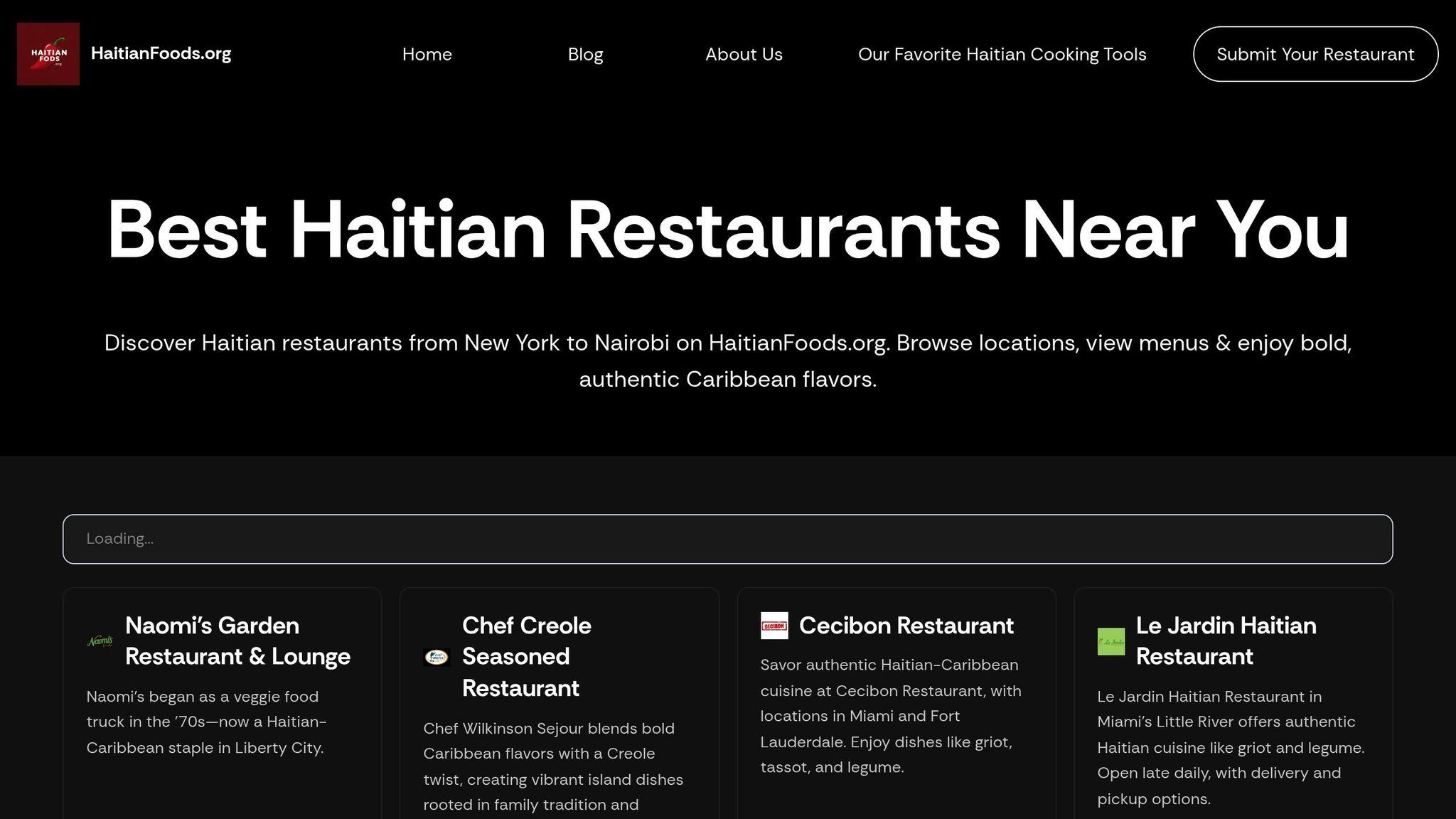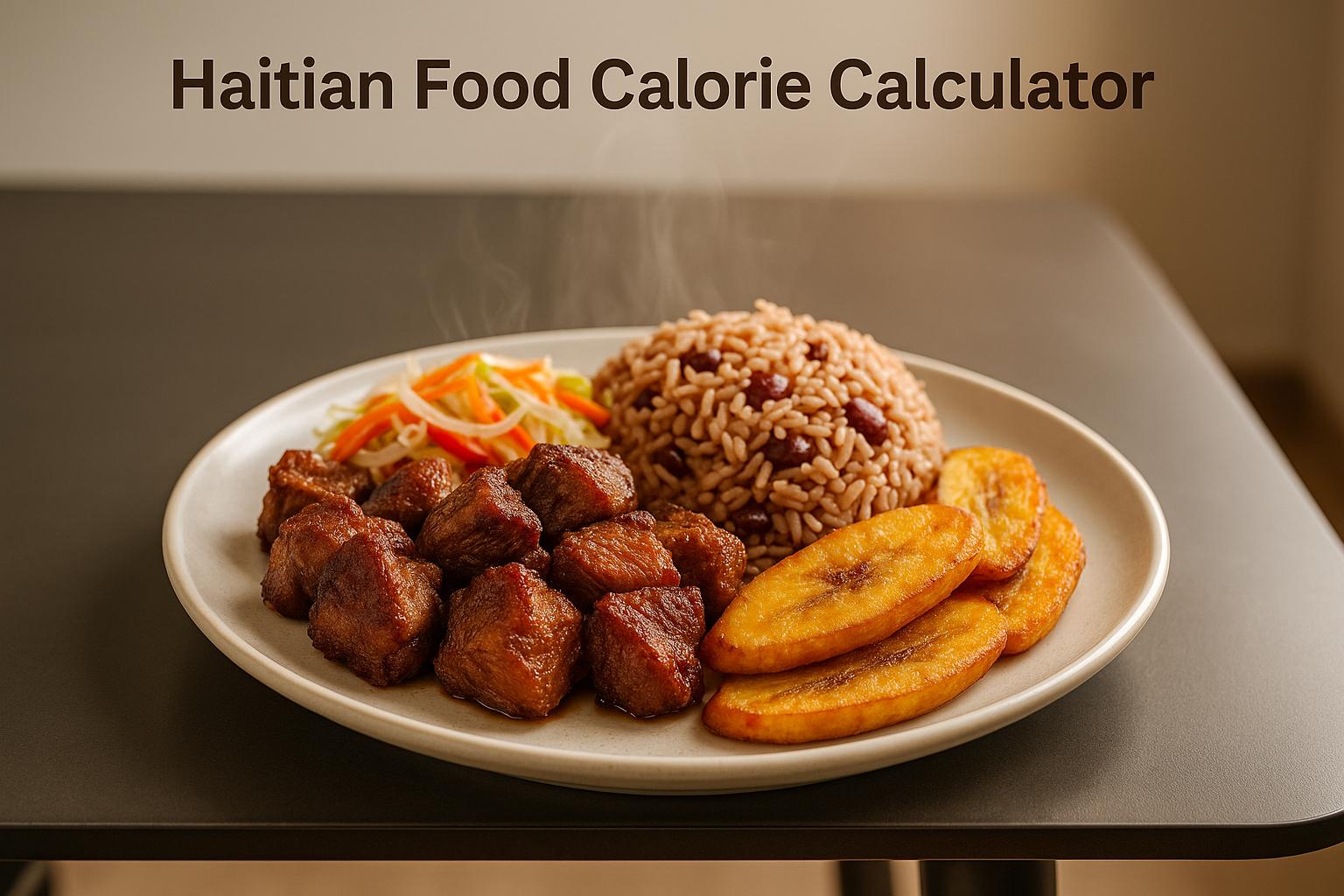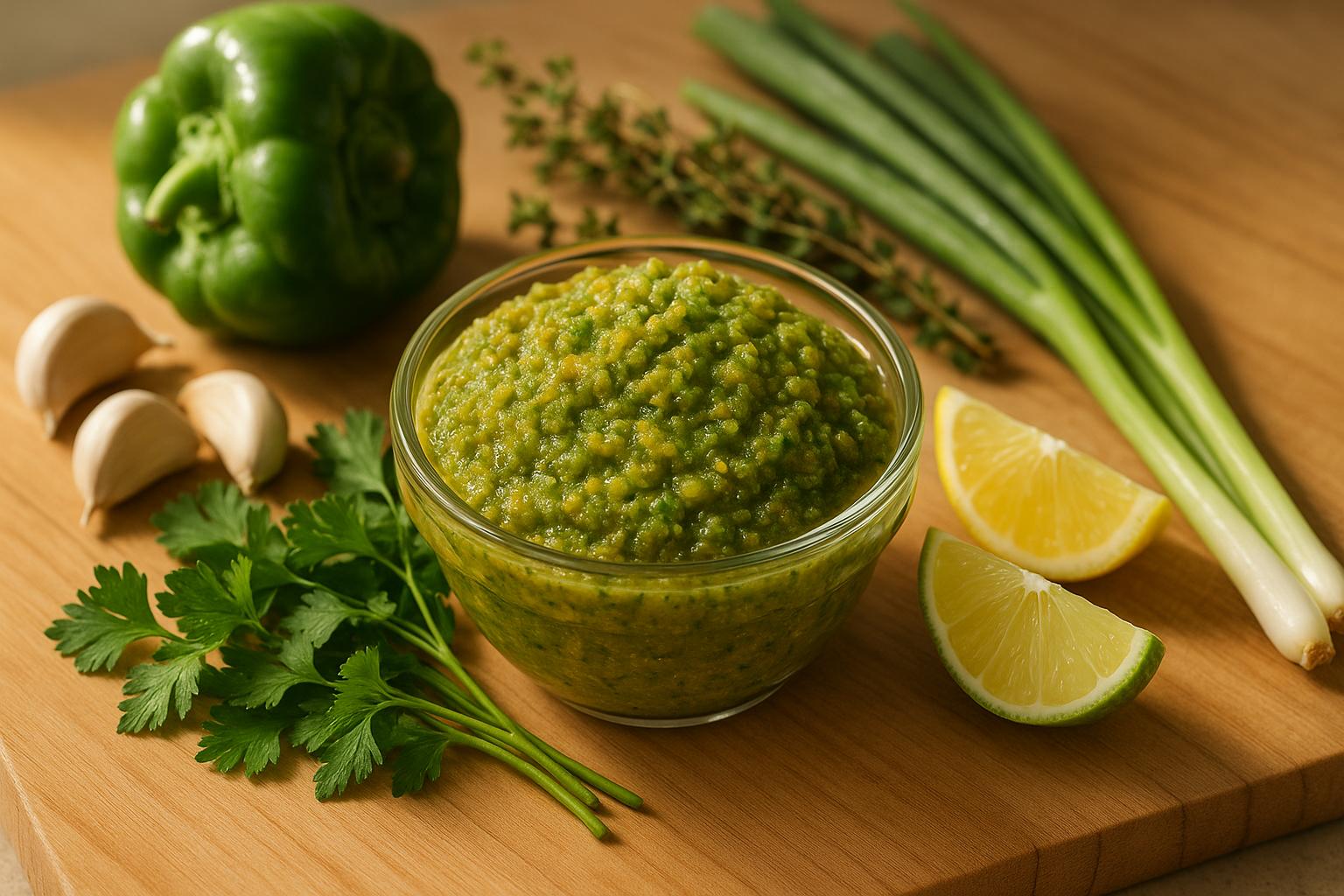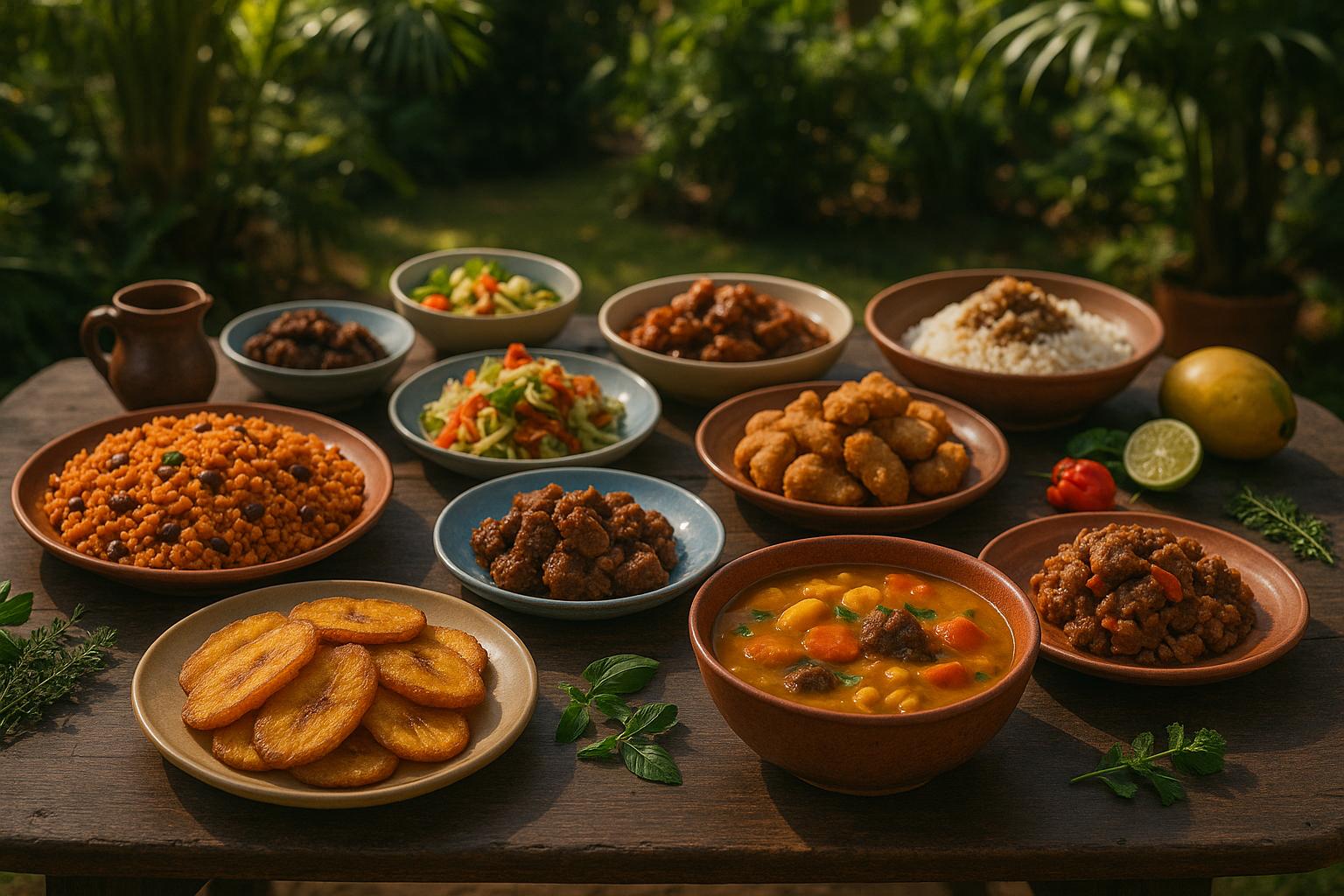Mangoes are deeply woven into Haitian life, serving as a key food source, an economic driver, and a symbol of heritage. With over 10 million mango trees across Haiti, this fruit is vital for both nutrition and income, especially the prized Francis mango variety. Mangoes are Haiti’s second-largest export crop, and their versatility shines in recipes like juices, salsas, and savory dishes.
Key points:
- Francis mango: Haiti's national fruit tree, known for its sweet, fragrant flavor.
- Economic role: Mango exports generate millions annually, though challenges like U.S. import suspensions impact farmers.
- Seasonality: Mango season runs from April to September, with over 100 varieties grown.
- Culinary uses: Mango is featured in drinks like Ji Mango and savory dishes like Spicy Mango Salsa.
Mangoes also provide health benefits, offering high levels of Vitamin C, Vitamin A, and antioxidants. Whether enjoyed fresh, juiced, or cooked, this fruit remains a cornerstone of Haitian cuisine and culture.
How to Make traditional Haitian Mango Juice (Ji Mango)
How to Select and Prepare Mangoes for Haitian Recipes
Getting mangoes just right is key to bringing out their best flavor in Haitian cooking. Here's how to pick, prepare, and store them for your dishes.
How to Pick Ripe Mangoes
When choosing mangoes, don’t rely solely on color - it’s not always an indicator of ripeness. Instead, try the squeeze test. Gently press the mango; a ripe one will feel slightly soft, much like a ripe peach or avocado. Also, pick the heavier mango when comparing fruits of similar size - this usually means it’s packed with juicy, dense flesh [4][5].
Your nose can also help. Sniff the stem area - ripe mangoes often give off a strong, fruity aroma [5]. Look for white or brown speckles on the skin, as these can also signal ripeness [7]. Keep in mind that mangoes are often harvested before they’re fully ripe to survive shipping, so they can be enjoyed at various stages - from tart and firm to lusciously sweet [5][6].
Once you’ve picked the perfect mango, the way you prep it will make all the difference in your recipe.
How to Prepare Mangoes for Cooking
For easier handling, start with firm mangoes - they’re less slippery when peeling [8]. A popular method is the "hedgehog" technique: slice the mango in half, score the flesh into a grid pattern without cutting through the skin, then flip the half inside out to expose the cubes. You can slice these right into a bowl [8][10].
Another option is peeling the mango with a knife or vegetable peeler, then slicing it lengthwise to remove the flesh. If you want to get creative, try the wine glass hack - cut off the mango sides and use the rim of a wine glass to scoop out the flesh cleanly [10].
For Haitian recipes like spicy mango salsa, firmer varieties such as Baptiste or Francique work best [9][12]. If you’re making drinks like Haitian mango juice, simply puree the mango in a blender and strain it for a smooth texture [11][13].
If the mango gets too soft while prepping, use a corn-on-the-cob holder to steady it as you slice [8]. Once prepped, proper storage will keep your mangoes fresh and flavorful.
How to Store Mangoes
To keep your mangoes at their peak, store unripe ones at room temperature. Want to speed things up? Put them in a paper bag with a banana. Once ripe, refrigerate them for up to five days [14].
"Mangoes continue to ripen off the tree, so proper storage at different phases ensures an optimal mango eating experience that is soft, juicy, and aromatic"
- Desiree Pardo Morales, founder and president of Tropical Fruit Box [16]
Keep ripe mangoes away from ethylene-sensitive produce like strawberries and broccoli, but feel free to store them alongside ethylene-producing fruits like apples and avocados [15]. If you’ve already cut your mangoes, refrigerate them immediately in an airtight container - they’ll last up to a week [15].
For longer storage, peel and slice the mango, lay the pieces on a parchment-lined baking sheet, and freeze for at least two hours. Once frozen, transfer the pieces to a freezer-safe bag. Frozen mangoes can keep for up to six months [14][15]. When you’re ready to use them, thaw in the fridge overnight or place them in cold water for about three hours. This method helps maintain their texture and flavor, making them perfect for your Haitian recipes [15].
Popular Haitian Recipes with Mango
Dive into Haitian recipes where mango adds its luscious sweetness to both refreshing drinks and savory dishes.
Haitian Mango Juice (Ji Mango)
Ji Mango is a beloved staple in Haitian households, capturing the pure, tropical essence of ripe mangoes.
As food blogger Manie Chery describes:
"This juice is simple to recreate, simple ingredients and oh so delicious. You can make this with any kind of mangoes but if you can find the Haitian mango (Francis) it truly enhances the flavor." [13]
In August 2022, Love For Haitian Food shared a recipe that calls for 3 ripe Haitian mangoes, the juice of 2 limes, 2 teaspoons of Noyau (almond extract), and ¼ to ½ cup of sugar, depending on your taste [13]. Start by blending the mango flesh with 1 cup of water until smooth, then strain to remove any pulp for a silky texture. Stir in 4 cups of water, lime juice, sugar, and almond extract. For the most authentic flavor, use the Francis mango variety, but any ripe mango will do. Serve immediately to enjoy it at its freshest.
Mango Lemonade
This twist on traditional Haitian lemonade combines the tang of lemons with mango's tropical sweetness. Savory Thoughts highlighted it in 2023, saying:
"This Mango Lemonade recipe offers a fresh spin on the much-loved Haitian lemonade drink, with an extra fruity hit and an even more tropical taste." [17]
The recipe includes 2½ cups of mango chunks, 8 cups of water, ½ cup of sugar, 1 teaspoon of vanilla extract, ¼ teaspoon of kosher salt, and the juice of 4 lemons [17]. Vanilla extract - a signature ingredient in Haitian lemonade - adds a warm, aromatic depth [18]. Blend the mango chunks with some of the water to create a smooth base, then mix in the rest of the ingredients. You can personalize the drink by tossing in other fruits like strawberries or pineapple, or even adding a splash of vodka or rum for a grown-up version.
Mango isn’t just for drinks - it also shines in savory Haitian dishes.
Mango in Savory Dishes
Though mangoes are often enjoyed fresh or juiced, they’ve found a home in modern Haitian-inspired savory recipes.
Spicy Mango Salsa is a vibrant condiment that blends diced mango with piment bouc (Haitian hot peppers), shallots, purple onion, bell pepper, lime juice, parsley, and olive oil [12]. It’s a natural pairing for grilled fish, crackers, or cassava chips, offering a balance of sweet and spicy.
For a bold entrée, try Grilled & Flambé Beef Filet Skewered with Mango. This dish features seasoned beef filet chunks skewered alongside mango pieces and purple onion, grilled to perfection, and flambéed with dark rum. The flavorful mango sauce combines mango chunks, onion, bell pepper, garlic, brown sugar, piment bouc, tomato, rice wine vinegar, lime juice, and ginger [19].
Another standout is Spicy Ginger Lobster with Mango Salsa, where the cool, sweet mango salsa balances the heat of the seasoned lobster. This pairing highlights mango’s ability to complement spicy proteins while adding a refreshing contrast [19].
These savory dishes showcase mango’s versatility in Haitian cuisine. Its natural sweetness and acidity brighten rich, spicy flavors, tenderize meats, and add complexity to sauces and marinades, making it an indispensable ingredient.
Health Benefits and Cooking Uses of Mangoes
Mangoes are more than just a tropical treat - they're packed with nutrients and add a burst of flavor to both sweet and savory dishes, making them a versatile ingredient in Haitian cuisine.
What Nutrients Mangoes Provide
Mangoes are loaded with over 20 essential vitamins and minerals in every serving [20]. A single cup (165 grams) of fresh mango delivers an impressive 67% of your daily Vitamin C needs and 10% of your daily Vitamin A, all for under 100 calories [21].
In addition to Vitamins C and A, mangoes are a good source of copper, folate, Vitamin E, and several B vitamins [20][21]. These nutrients work as antioxidants, helping protect your cells from damage while also supporting heart health, immunity, digestion, and vision [20][21][22]. Plus, the same 165-gram serving of mango contains 277 mg of potassium, which is about 6% of the daily requirement for adults [23].
Maya Vadiveloo, an assistant professor in the department of nutrition and food sciences at the University of Rhode Island, highlights the fruit’s wide-ranging benefits:
"Vitamin C is good for immunity... It's an antioxidant so it can help with oxidative stress in the body. The primary benefit, in addition to being a really good source of vitamin C, is that (mangoes) are a decent source of vitamin A, folate and are pretty high in fiber, which is beneficial for colon cancer prevention, heart disease and weight control." [20]
To enjoy these benefits while keeping things balanced, aim for a serving size of about 1 cup (165 grams). Since mangoes are naturally higher in sugar than many other fruits, pairing them with protein- or fiber-rich foods can help keep blood sugar levels steady [21].
Using Mangoes in More Than Desserts
Mangoes aren’t just for smoothies and desserts - they bring a unique mix of sweetness and acidity that can elevate savory Haitian dishes. Their natural enzymes and bright flavor make them perfect for salsas, marinades, and more.
Mango salsas and sauces are a great way to enhance proteins. Try pairing diced mango with jalapeño for a vibrant topping on tacos or grilled chicken [24]. For something heartier, whip up a curry-style mango sauce with chicken, spinach, or sweet peas, and serve it over rice [26].
Marinades and seasonings benefit from mango’s natural tenderizing properties. A mango-lime marinade, for example, adds tropical flavor while keeping grilled chicken juicy [24]. Or, slice semi-ripe mangoes thinly and season them with sea salt, chili-lime powder, lime juice, and olive oil for a refreshing mango carpaccio [25].
Seafood dishes are another area where mango shines. Its acidity balances out the richness of seafood, making it a perfect match for grilled lobster or fish tacos. Add mango to a cooling salsa or use it as a fresh topping to brighten these dishes [19][23].
Creative sides and salads show just how versatile mangoes can be. Toss them into slaws for burgers, add diced mango to fruit salads for an extra dose of Vitamin C, or blend frozen mango with pineapple juice and strawberries for a nutrient-packed smoothie [23][24].
From a health perspective, mangoes also have some surprising benefits. A 2014 study by Evans, S. F., et al. found that consuming freeze-dried mangoes helped reduce blood sugar levels in individuals with obesity, showing that mangoes can be a thoughtful addition to a balanced diet [23].
sbb-itb-80c33ff
Mango's Place in Haitian Food History and Restaurants
Mango as Part of Haitian Heritage
Mango holds a cherished spot in Haitian culinary traditions, symbolizing both cultural pride and practical sustenance. Known as "Mango Land" for its over 100 varieties, Haiti celebrates this fruit as a national treasure. Among the many types, Francique, Baptiste, Corn, Fil, Mme. Blanc, Prune, and Carrotte stand out as favorites[3].
Mango season in Haiti is more than just a harvest - it’s a time for community and family gatherings. People come together to pick, share, and enjoy the fruit, creating moments that reinforce their bond with this natural gift[2]. Beyond its cultural significance, mangoes play a crucial role in addressing food insecurity by providing essential nutrients during their peak season. Many also preserve the fruit to ensure its availability year-round[2].
Among the varieties, the Francique mango is particularly prized, often considered the crown jewel of Haitian mangoes[3]. This deep connection to mangoes has inspired Haitian chefs and restaurants to incorporate the fruit into both traditional and contemporary dishes.
Mango in Restaurant Menus and New Dishes
Haitian restaurants have embraced mango as a versatile ingredient, crafting menus that honor its heritage while exploring new culinary possibilities. From classic recipes to modern fusion dishes, mango continues to shine as a key flavor.
Mango-based beverages remain a favorite in Haitian cuisine. For instance, Love For Haitian Food offers a traditional Haitian Mango Juice recipe made with ripe mangoes, lime juice, Noyau (almond extract), and sugar[13]. This classic drink is a staple on many Haitian menus.
Beyond beverages, mango finds its way into salsas, entrees, and creative fusion dishes. Tchakayiti has developed a Spicy Mango Salsa served tostada-style on crispy cassava[12]. Jungle Jim's International Market offers a Haitian Mango Chicken dish featuring a sauce made from pureed mango, orange juice, sherry, and candied ginger[27]. Black Foodie presents a vibrant Tostones & Spicy Mango Chow, a Trinidadian-inspired salad with diced mango and tropical flavors, perfect for summer dining[28].
Finding Haitian Cuisine Through HaitianFoods.org

For those eager to explore authentic Haitian cuisine, HaitianFoods.org is an invaluable resource. This directory connects food enthusiasts with Haitian restaurants across the United States, many of which feature mango-based dishes.
Highlighted establishments include Naomi's Garden Restaurant & Lounge in Liberty City, Chef Creole Seasoned Restaurant, and Cecibon Restaurant, all located in Miami and Fort Lauderdale. These spots showcase the rich flavors and culinary diversity of Haitian food.
HaitianFoods.org goes beyond just restaurant listings. The platform includes a blog filled with recipes, cultural stories, and tips that deepen your appreciation for Haitian cooking. It also supports Haitian-owned businesses by allowing restaurant owners to submit their establishments for inclusion.
Whether you're searching for a traditional Ji Mango or inventive mango fusion dishes, HaitianFoods.org offers the tools to explore the vibrant world of Haitian cuisine. Mango remains at the heart of this tradition, continuing to inspire chefs and delight diners alike.
Conclusion: Mango as a Foundation of Haitian Cooking
In Haitian cuisine, mango isn't just a fruit - it's a cornerstone of culinary tradition. With around 10 million mango trees scattered across the country, this tropical gem plays a vital role in both the daily lives of Haitians and the nation’s economy [1]. It’s more than food; it’s a symbol of cultural identity and a key economic driver.
Nutritionally, mangoes pack a punch. They’re rich in vitamin C, vitamin A, folate, antioxidants, potassium, and enzymes that promote better digestion, heart health, and a stronger immune system [21][30]. This makes them as beneficial for the body as they are for the table.
Mangoes find their way into a variety of Haitian dishes, both traditional and modern. Whether it’s a tangy mango salsa paired with crispy Haitian cassava or a creative fusion like mango chicken with a mango puree sauce, this versatile fruit inspires cooks across the spectrum. Food blogger Annick Mégie describes their magic perfectly:
"As for mangos, I will simply say that they bring a dish to life. Think about their gorgeous orange color. It brightens salads, a glass of juice, and in this case my crispy Haitian cassava." [12]
Beyond their culinary uses, mango trees contribute to reforestation efforts and soil protection, while their leaves are used in traditional remedies [3][29]. Every dish made with mango carries not just flavor but also a nod to sustainability and well-being.
From refreshing Ji Mango to green mango chutneys, or sampling dishes at authentic Haitian restaurants, every bite tells a story of tradition and innovation. Dive into this rich culinary heritage by exploring recipes at home or dining out - each mango-filled creation connects you to a vibrant legacy that continues to thrive and evolve. Visit HaitianFoods.org to start your journey into the heart of Haitian mango-inspired cuisine.
FAQs
How do mangoes impact Haiti's economy, and what challenges do farmers face in exporting them?
The Role of Mangoes in Haiti's Economy
Mangoes are a vital part of Haiti's economy, generating over $10 million each year through exports. This thriving industry not only boosts the country's economy but also provides essential income for countless local farmers and supports the daily lives of many communities across Haiti.
But exporting mangoes isn't without its challenges. Farmers often grapple with security threats and logistical difficulties, which have caused setbacks like the suspension of the USDA preclearance program in early 2023. On top of that, the U.S. has temporarily stopped importing Haitian mangoes due to rising complications, putting the industry’s future at risk.
These challenges underscore the urgent need for better infrastructure and resources to secure the stability and growth of Haiti's mango industry.
How can I choose and prepare mangoes to bring out their best flavor in Haitian recipes?
To choose the best mango for Haitian dishes, focus on fruits with bright red and yellow tones, a gentle softness when pressed, and a sweet, fruity scent at the stem. These are clear indicators of ripeness. Steer clear of mangoes that are overly firm or have wrinkled skin, as they may either be unripe or past their prime.
When it’s time to prepare your mango, start by giving it a good wash. You can peel the skin and slice the flesh, or use a handy trick: score the mango into a grid pattern, then flip the skin inside out. This creates neat, easy-to-cut cubes. Not only does this method simplify handling, but it also brings out the mango’s texture and flavor - perfect for dishes like mango sauces, fresh salads, or sweet desserts that are staples in Haitian cuisine.
How are mangoes used in Haitian savory dishes, and why are they such a versatile ingredient?
Mangoes are a staple in Haitian savory dishes, offering a delightful mix of sweetness and tanginess that complements the bold flavors of the cuisine. You’ll find them in recipes like mango salsas, green mango salads, and rich mango-based sauces, all of which pair wonderfully with the spices and seasonings typical of Haitian cooking.
Their versatility is evident in dishes like mango chicken, zesty mango salads, and even grilled mango creations. Whether served fresh or cooked, mangoes add a bright, tropical flair to meals, earning their place as a cherished ingredient in Haitian kitchens.


